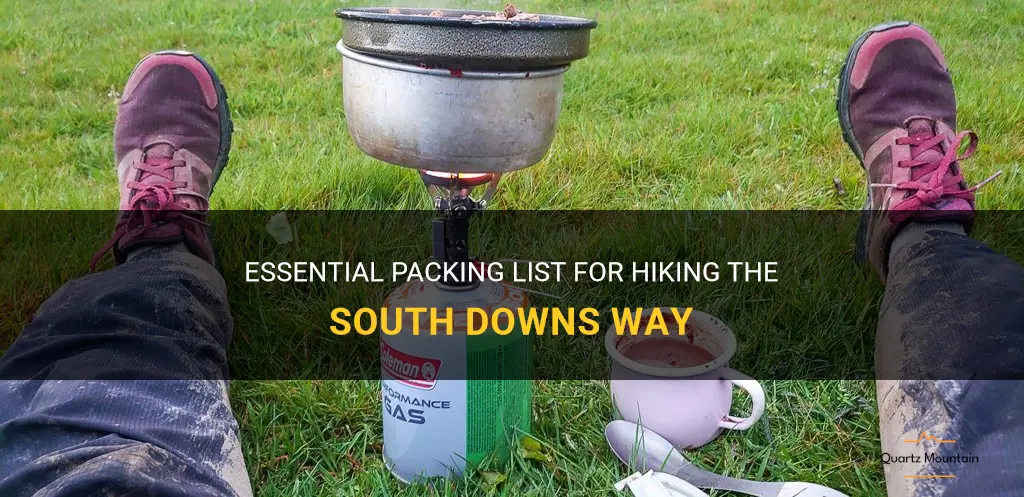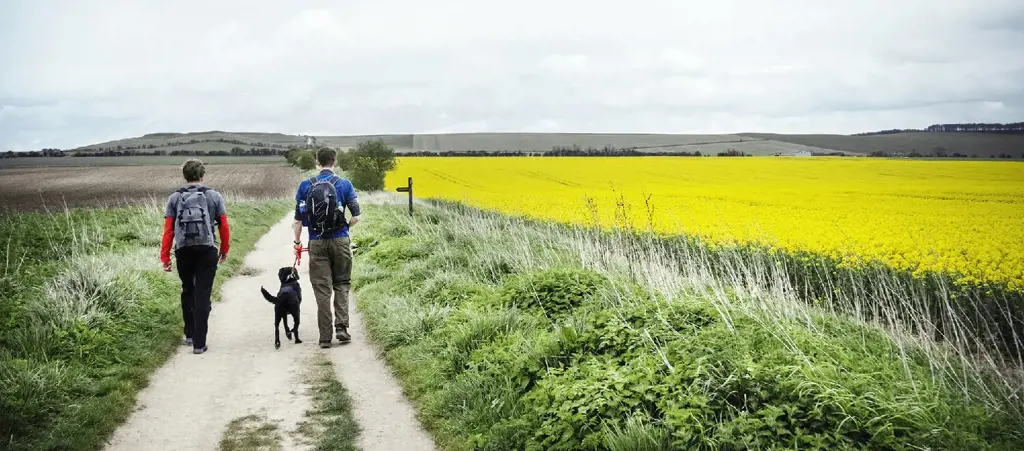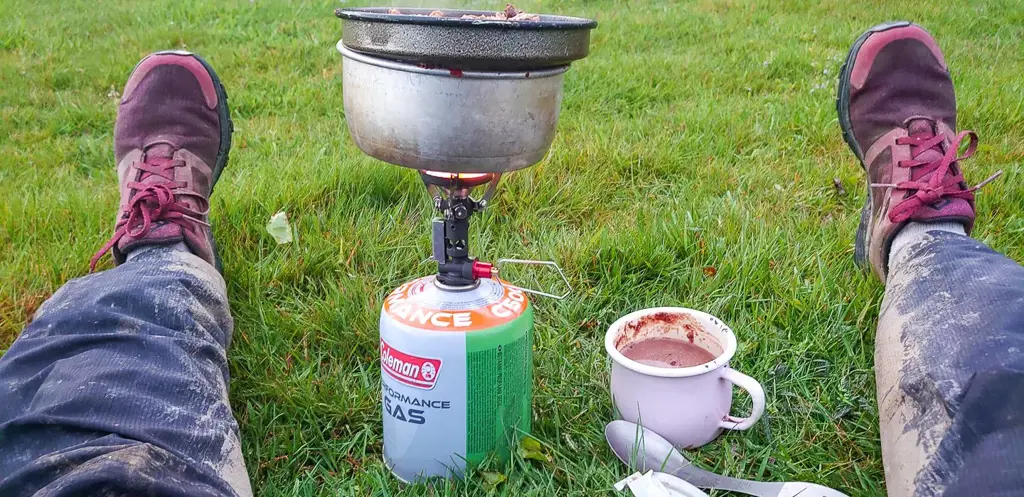
Are you planning to embark on an adventure along the breathtaking South Downs Way? The South Downs Way is a stunning 100-mile trail that stretches across the beautiful landscapes of Southern England. From rolling hills and picturesque villages to ancient woodlands and chalk cliffs, this trail offers hikers an unforgettable experience. However, before you set off on this epic journey, it's essential to pack everything you need for a safe and comfortable hike. In this article, we will provide you with an essential packing list that will ensure you have all the necessary gear and supplies to conquer the South Downs Way. So, grab your backpack and let's get packing!
What You'll Learn
- What are the essential items to pack for hiking the South Downs Way?
- Are there any specific clothing recommendations for the South Downs Way?
- Is it necessary to bring camping equipment for the South Downs Way?
- What types of snacks or meals should be packed for the trail?
- Are there any safety items or emergency supplies that should be included in the pack?

What are the essential items to pack for hiking the South Downs Way?

Hiking the South Downs Way is a wonderful adventure that allows you to explore the natural beauty of the South Downs National Park in southern England. As with any hiking trip, it is important to be prepared and pack the right gear. In this article, we will discuss the essential items to pack for hiking the South Downs Way.
- Backpack: A good quality backpack is essential for carrying all your gear during the hike. Look for one that is comfortable, lightweight, and has enough space to hold all your essentials.
- Hiking Boots: With a variety of terrain, including gravel paths and grassy slopes, it is important to have a reliable pair of hiking boots. Choose ones that provide ankle support and have a good grip on both wet and dry surfaces.
- Clothing: Dressing in layers is key when hiking the South Downs Way, as the weather can change quickly. Bring a lightweight and breathable base layer, a warm mid-layer, and a waterproof outer layer. Don't forget a hat, gloves, and sunglasses to protect yourself from the sun.
- Navigation Tools: While the South Downs Way is well signposted, it is always a good idea to have a map and compass as a backup. Familiarize yourself with the route before you set off and have a way to keep track of your progress.
- Water and Snacks: Staying hydrated and fueled during the hike is important. Bring a reusable water bottle and pack plenty of high-energy snacks such as trail mix, energy bars, and fresh fruit.
- First Aid Kit: Accidents can happen, so it is essential to have a first aid kit with you. Include items such as bandages, antiseptic wipes, pain relievers, blister patches, and any personal medications you may require.
- Sunscreen and Insect Repellent: Protect your skin from harmful UV rays by applying sunscreen before setting off on your hike. Additionally, bring an insect repellent to ward off any pesky bugs that may be present along the trail.
- Mobile Phone and Charger: While you may want to disconnect and enjoy the serenity of nature, it is important to have a fully charged mobile phone with you in case of emergencies. Ensure your phone is in a waterproof case and bring a portable charger to keep it powered up.
- Camping Gear (if applicable): If you plan to camp along the South Downs Way, be sure to pack a lightweight tent, sleeping bag, sleeping pad, and cooking equipment. It is also advisable to bring some extra warm clothing for the cool nights.
- Personal Essentials: Lastly, don't forget to pack personal essentials such as toiletries, a towel, a flashlight or headlamp, a pocket knife, and a whistle for emergencies.
Remember to pack light and only bring what you truly need for the hike. Carrying unnecessary weight can make the journey more challenging. By packing these essential items, you will be well-prepared for hiking the South Downs Way and can focus on enjoying the stunning landscapes and unforgettable experiences along the trail.
Essential Packing Tips for Your Pumpkin Island Getaway
You may want to see also

Are there any specific clothing recommendations for the South Downs Way?

The South Downs Way is a popular hiking trail in England that stretches across 100 miles from Winchester to Eastbourne. With its diverse terrain and unpredictable weather, it's important to dress appropriately for a comfortable and enjoyable hiking experience. Here are some clothing recommendations for the South Downs Way.
Layering is key:
The weather on the South Downs Way can be quite changeable, so it's important to dress in layers that you can easily take off or put on as needed. Start with a moisture-wicking base layer that will keep you dry and comfortable. On top of that, add a lightweight, insulating mid-layer to provide warmth. Finally, top it off with a waterproof and breathable outer layer to protect you from rain and wind.
Choose lightweight and breathable materials:
When hiking a long distance, you want to minimize the weight of your clothing. Opt for lightweight materials that won't weigh you down or restrict your movement. Look for breathable fabrics that will help regulate your body temperature and prevent overheating.
Dress for all seasons:
The South Downs Way can be hiked year-round, so you need to be prepared for all kinds of weather. In the summer, wear lightweight and breathable clothing to stay cool. A hat and sunglasses are also essential to protect yourself from the sun. In the winter, layer up with thermal base layers, fleece jackets, and waterproof outer layers to stay warm and dry.
Wear sturdy and comfortable footwear:
A good pair of hiking boots is essential for tackling the varied terrain of the South Downs Way. Look for boots that provide ankle support and have a rugged sole for traction. Make sure they are properly broken in before your hike to prevent blisters and discomfort.
Don't forget accessories:
Pack a hat, gloves, and a neck gaiter or scarf to protect yourself from the elements. These accessories can make a big difference in your comfort level, especially on colder and windier days. Additionally, bring a backpack with a rain cover to keep your gear dry, and consider packing a lightweight, packable down jacket for added warmth during breaks or in the evenings.
Remember, these are just general recommendations. It's essential to check the weather forecast before your hike and adjust your clothing accordingly. Also, take into account your personal preferences and comfort levels. The most important thing is to dress in a way that keeps you dry, comfortable, and protected from the elements, so you can fully enjoy your experience on the South Downs Way.
What to Pack for a Trip to Italy in April: Essential Items to Bring
You may want to see also

Is it necessary to bring camping equipment for the South Downs Way?

The South Downs Way is a popular long-distance trail that stretches for 100 miles along the South Downs in England. It offers stunning views, a variety of terrain, and a chance to immerse oneself in nature. As such, many people choose to tackle this trail as a multi-day adventure, and the question of whether to bring camping equipment often arises. So, is it necessary to bring camping equipment for the South Downs Way?
The answer to this question ultimately depends on your personal preferences and the itinerary you have in mind. There are a few factors to consider when making this decision:
- Length of the trail: The South Downs Way is a long-distance trail that typically takes 6-9 days to complete. If you plan on completing the trail in one go, it might be necessary to bring camping equipment. However, if you plan on doing the trail in sections and staying in towns or accommodations along the way, camping equipment may not be necessary.
- The availability of accommodations: Along the South Downs Way, there are several towns and villages that offer accommodations, including hotels, bed and breakfasts, and hostels. If you prefer the comfort and convenience of staying in these accommodations, then you may not need camping equipment. However, it's important to research and book accommodations in advance, especially during peak hiking seasons.
- The desire for a wilderness experience: One of the main advantages of bringing camping equipment is the ability to venture off the beaten path and camp in the wilderness. If you enjoy the solitude and serenity of camping out under the stars, then bringing camping equipment may enhance your South Downs Way experience.
- Weight and logistics: It's important to consider the weight and logistics of carrying camping equipment for the duration of the trail. Camping gear can be bulky and add significant weight to your pack. If you're comfortable carrying the extra weight and have the necessary logistics in place, then bringing camping equipment may be worth it.
It's also worth noting that wild camping is not permitted along the entire South Downs Way. However, there are designated camping areas available at certain points along the trail. It's important to research and plan accordingly if you choose to camp along the South Downs Way.
In conclusion, bringing camping equipment for the South Downs Way is not necessary but can enhance your experience depending on your preferences and itinerary. It's important to consider factors such as the length of the trail, the availability of accommodations, your desire for a wilderness experience, and the weight and logistics of carrying camping gear. Planning ahead and making an informed decision will ensure that you have a memorable and enjoyable South Downs Way adventure.
The Essential Wardrobe: What Clothes to Pack for an MSC Cruise
You may want to see also

What types of snacks or meals should be packed for the trail?

When going on a hike or camping trip, it is important to pack the right snacks and meals to keep you energized and fuel your body for the trail. The type of snacks and meals you pack will depend on the duration of your hike, your dietary needs, and personal preferences. In this article, we will discuss various types of snacks and meals that are suitable for the trail, including both pre-packaged options and homemade alternatives.
Pre-packaged Snacks:
- Energy bars: Choose bars that are high in protein and fiber, and low in added sugars. Look for bars that contain nuts, seeds, and dried fruit for a combination of healthy fats, protein, and natural sugars.
- Trail mix: A mix of nuts, seeds, dried fruits, and maybe some chocolate or granola can provide a quick and easy snack on the trail. Look for trail mix options that don't contain added sugars or unhealthy fats.
- Jerky: Beef, turkey, or vegan jerky can be a good source of protein for a long hike. Look for options that are low in sodium and preservatives.
- Nut butter packets: Single-serving packets of almond or peanut butter can be a great source of healthy fats and protein. Pair them with crackers or a banana for a delicious snack.
Homemade Snacks:
- Energy balls: Made with a mixture of oats, nut butter, honey, and add-ins like dried fruits or chocolate chips, energy balls are a portable and customizable snack. You can make a big batch ahead of time and pack them for the trail.
- Homemade granola: Make your own granola using oats, nuts, seeds, and dried fruits. This way, you can control the amount of sugar and add your favorite ingredients.
- Veggie sticks with hummus: Cut up carrots, celery, and bell peppers and pack them with a small container of hummus. This snack will provide hydration, fiber, and essential nutrients.
- Sandwiches or wraps: Make sandwiches or wraps with lean protein, such as turkey or chicken, and pack them with lots of veggies. Opt for whole-grain bread or wraps for added fiber.
Meals for the Trail:
- Dehydrated meals: There are many pre-packaged dehydrated meal options available that only require hot water to rehydrate. Look for meals that are high in protein and contain a good balance of carbohydrates and healthy fats.
- Pasta or rice dishes: Cook pasta or rice ahead of time and toss it with your choice of protein (chicken, shrimp, tofu) and vegetables. Pack it in a sealed container for an easy and filling meal on the trail.
- Soup or chili: Make a big batch of your favorite soup or chili and freeze individual portions in zip-top bags. These can be heated up on the trail for a comforting and nutritious meal.
When packing snacks and meals for the trail, it is important to consider factors such as weight, shelf life, and storage requirements. Choose options that are lightweight, non-perishable, and can withstand various weather conditions. It is also essential to pack enough water and stay hydrated throughout your hike. With the right snacks and meals, you can enjoy your time on the trail while keeping your energy levels up and your taste buds satisfied.
Essential Items to Pack in Your Personal Item Bag for Travelers
You may want to see also

Are there any safety items or emergency supplies that should be included in the pack?

Emergency preparedness is crucial in ensuring the safety and well-being of yourself and your loved ones in the event of a disaster or emergency situation. One important aspect of emergency preparedness is having a well-equipped emergency pack or bug-out bag. This pack should contain essential items that can help you survive and stay safe until help arrives or the situation improves. Among the necessary items to include in your emergency pack are safety items and emergency supplies.
When it comes to safety items, it is recommended to have a reliable and durable flashlight or headlamp. In emergency situations, electricity may be disrupted, leaving you in darkness. A flashlight or headlamp will allow you to navigate your surroundings safely and efficiently, especially in the dark. Additionally, investing in extra batteries or a hand-crank flashlight can ensure a continuous source of light even without access to electricity.
Another safety item to include in your emergency pack is a whistle. Whistles are vital for attracting attention and signaling for help. They are lightweight, compact, and effective in alerting nearby individuals or rescue teams of your location. Three short blows on a whistle are universally recognized as a distress signal.
Emergency supplies should also be part of your emergency pack. One of the most essential supplies is water. It is recommended to have at least one gallon of water per person per day for a minimum of three days. Water is necessary for hydration and various everyday activities, such as cooking and sanitation. It is advisable to store water in sturdy containers that are resistant to breaking or leaking.
Another vital emergency supply is non-perishable food. It is important to choose food that does not require refrigeration, cooking, or special preparation. Examples include canned goods, energy bars, dried fruits, and nuts. Remember to check the expiration dates periodically and replace any expired items to ensure the freshness and safety of your emergency food supply.
A first aid kit is another crucial item to include in your emergency pack. It should contain essential medical supplies such as bandages, adhesive tape, antiseptic wipes, pain relievers, antibiotic ointment, and any necessary medications. It is essential to regularly inspect your first aid kit and replace any expired or used items.
In addition to the aforementioned safety items and emergency supplies, it is also beneficial to include a multi-purpose tool or utility knife, a waterproof and durable shelter, warm clothing, a blanket or sleeping bag, personal hygiene items, a portable phone charger, and a small amount of cash.
It is worth noting that the content of your emergency pack may vary depending on your location, climate, and specific needs. It is important to consider any unique needs such as medications, medical conditions, or dietary restrictions. Regularly reviewing and updating your emergency pack is also crucial to ensure that all items are in good condition and up-to-date.
In conclusion, safety items and emergency supplies are vital components of an emergency pack or bug-out bag. Having a reliable flashlight, a whistle, an adequate water supply, non-perishable food, a well-stocked first aid kit, and other essential items can greatly increase your chances of survival and readiness during an emergency or disaster situation. Remember to personalize your pack according to your specific needs and regularly check and update its contents for optimal preparedness.
Frequently asked questions
- When hiking the South Downs Way, it is important to pack a few essential items. These include a sturdy pair of hiking boots or shoes, a comfortable backpack to carry your supplies, a map or guidebook of the trail, plenty of water to stay hydrated, sun protection such as sunscreen and a hat, and appropriate clothing for the weather conditions. It is also helpful to bring a first aid kit and a mobile phone for emergencies.
- While there are some towns and villages along the South Downs Way where you can purchase food and snacks, it is recommended to bring your own provisions. Pack lightweight and easy-to-carry snacks such as energy bars, trail mix, and dried fruit. For meals, consider packing dehydrated or freeze-dried meals that can be easily prepared with hot water. This way, you will have food readily available even in more remote sections of the trail.
- Camping gear is not necessary for hiking the South Downs Way, as there are plenty of accommodation options along the trail. These include bed and breakfasts, inns, and campsites. However, if you prefer to camp, there are several campsites available along the route where you can pitch a tent. Be sure to check the regulations and availability of camping spots in advance.
- It is important to pack clothing appropriate for the weather conditions and season when hiking the South Downs Way. Layering is key to adapt to changing temperatures and weather conditions. Bring lightweight and breathable clothing that wicks away moisture, such as moisture-wicking shirts and quick-drying pants. It is also important to pack a waterproof jacket and pants in case of rain. Don't forget to bring extra socks and a hat to protect yourself from the sun.
- It is recommended to carry at least two liters of water per person per day when hiking the South Downs Way, especially during warmer months. Staying hydrated is crucial, so be sure to drink regularly and refill your water bottles whenever you come across a water source. Additionally, plan your route accordingly by knowing where you can access water along the trail, such as towns, cafes, or campsites.







